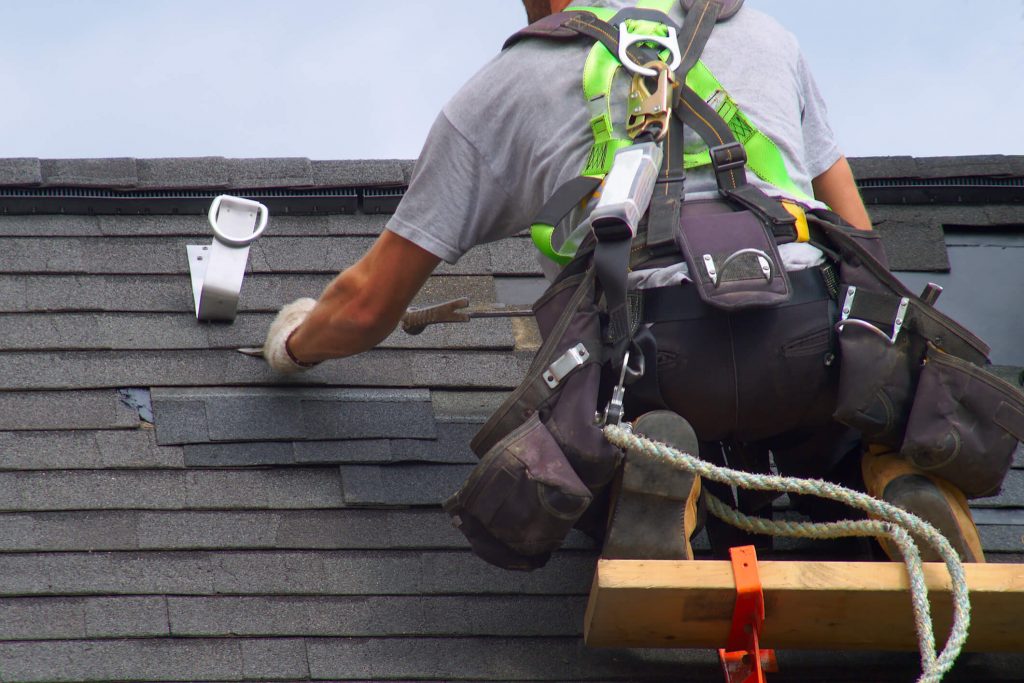Summary:
- Roof shingle installation requires careful planning, safety measures, and a specific approach based on the type of material you’re working with. Clearing the work area, checking the weather, and using sturdy equipment can make the process safer and more efficient.
- To prepare the roof, remove old shingles and install flashing around fixtures like chimneys and vents—this will prevent leaks. Planning the layout of shingles or tiles in advance will help preserve alignment and coverage so your new roof is durable and water-resistant.
- Installation techniques vary by material—proper nailing patterns for asphalt shingles, mortaring for clay tiles, and careful fastening for metal panels play a key role in longevity and stability. Wood shingles need a sheathing structure to prevent warping in damp climates.
- DIY roof installation is possible, but can be challenging and time-consuming. Hiring a professional guarantees installation goes off without a hitch, while Roof Maxx treatments can extend the life of your shingles by up to five years.
No matter how much you stay on top of routine roof maintenance and repairs, you’ll eventually need a new roof. Though it’s highly recommended to leave installing new roofing materials to an experienced roofing contractor, knowing how to install roof shingles can help you better maintain and preserve your roof.
The process is time-consuming and can be tricky if you’ve never worked on your roof before. This guide will give you a bit of insight into how to lay shingles the right way.
1. Take the Necessary Safety Precautions
Working on your roof can be dangerous if you’re not prepared. You need to do what you can to protect both yourself and your property from damage.
Clean the Work Area
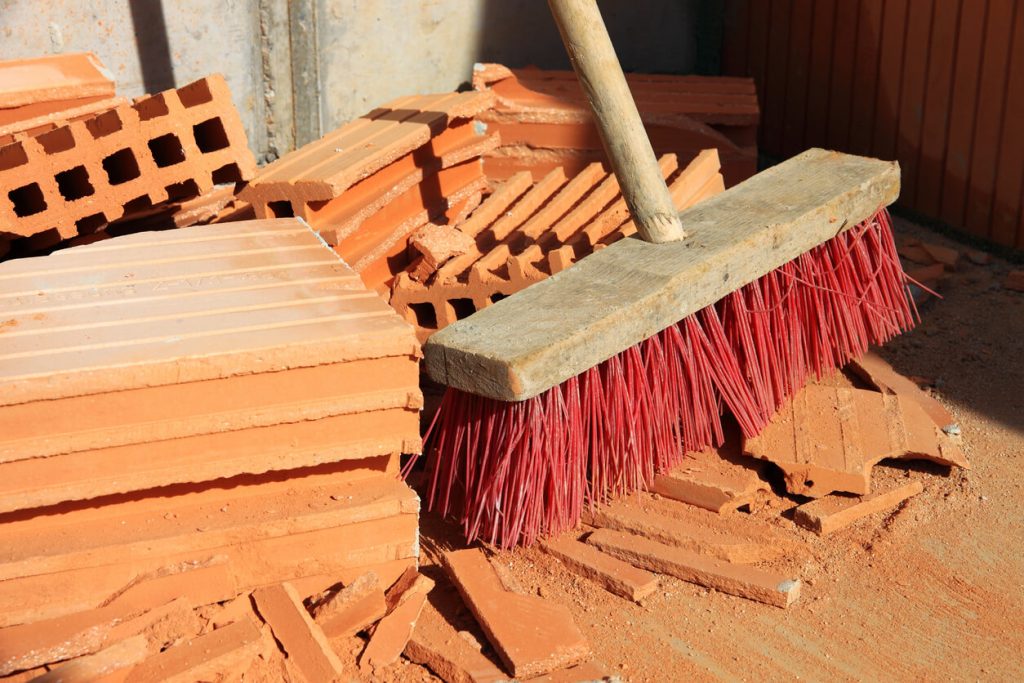
Start by cleaning the work area. Clear away any plant debris or obstacles that might turn into tripping hazards around the exterior of your home.
If you have plants close to the house, this is the time to cover them. Spread sturdy tarps or blankets over fragile plants to protect them from dropped tools and debris. Pull any yard games or lawn furniture away from the house to protect it from damage in the shingle installation process.
Check the Weather Forecast

When you’re learning how to put shingles on a roof, the first thing to bear in mind is that you’ll be working at quite a height. This means you need to make sure the weather conditions are favorable for the job.
If there are storms in the forecast or the humidity levels will be high enough to leave moisture on the existing shingles, put the job off. You’ll want to work on a day that’s dry, sunny, and comfortably warm. Great weather will ensure that you’re able to work quickly and safely until the new shingles are in place.
Wear the Right Clothes
Roofing work is highly physical labor, and the clothes you wear can have a huge impact in how easy it is for you to get the shingles down quickly. If you can, wear sturdy work pants like heavy denim jeans and a shirt that gives you a full range of motion in your shoulders.
Choose footwear with thick soles to protect your feet from any stray roofing nails on the ground. It’s also wise to invest in a good pair of leather gloves to help you carry heavy loads to and from the roof without hurting your skin.
Use Ladders Appropriately
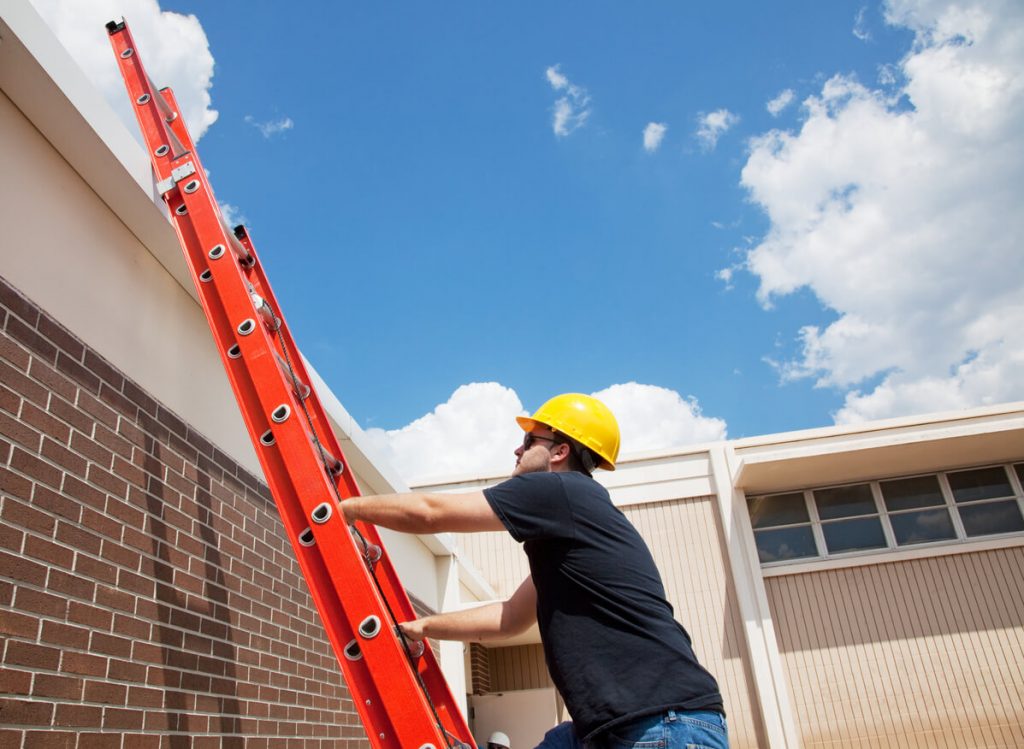
Before you start working, make sure your ladder is in good condition. The base should sit firmly on the ground and reach above the edge of your roof.
If the ladder is too short or unstable, replace it before you start working. And if you can, get someone to hold the base of the ladder while you’re on it to further improve stability.
2. Prepare the Roof
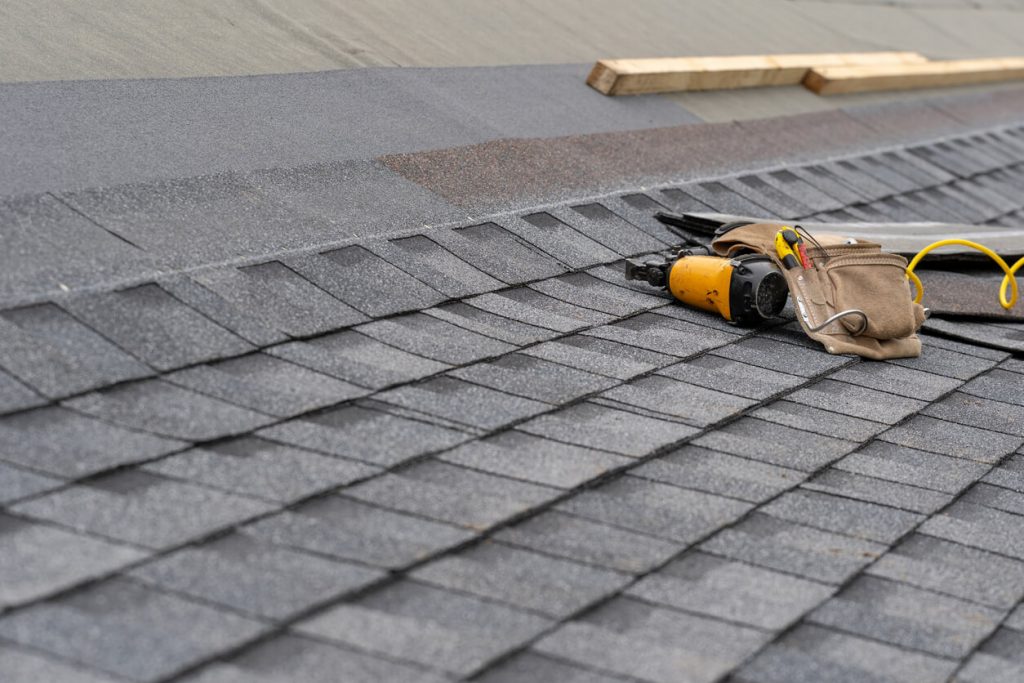
Once you’ve taken care of the necessary safety precautions, it’s time to get the roof itself ready for the project. Keep in mind that this process is incredibly time-consuming, difficult, and potentially expensive if you damage the support structure beneath the shingles.
If you can, leave it to the pros. If not, follow these steps.
Remove Large Pieces of Debris

Take the time to clean your roof’s surface thoroughly. Remove any large twigs, branches, and plant debris from the surface. If you’re replacing all of the shingles at once, you can sweep your roof with a soft-bristled broom.
Carefully Remove Old Roofing Materials
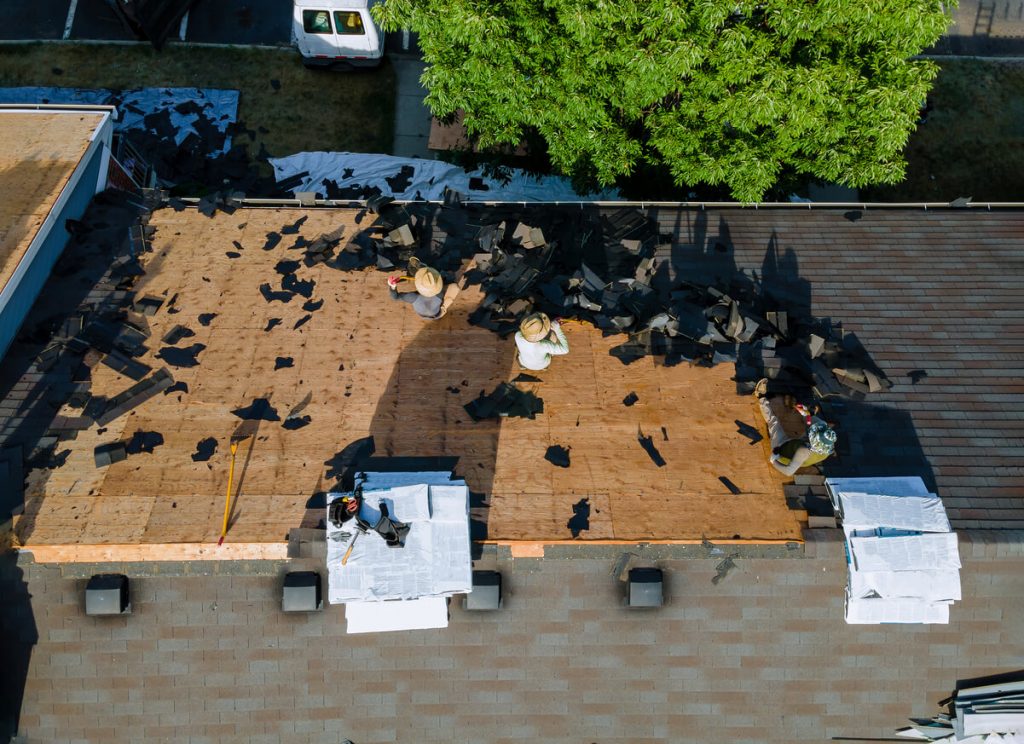
Once the surface is clean, it’s time to remove the old shingles. Start from the peak of the roof and, with a garden fork or shingle removing tool, pry the shingles up. They should come off in sheets with a bit of elbow grease.
Carry those sheets of shingles to the edge of the roof and drop them in a trash bin or designated pile. Keep going until each slope of the roof is clear.
Tip: It normally takes about three batches of asphalt shingles to cover 100 sq. ft. of a roof.
3. Install Flashing
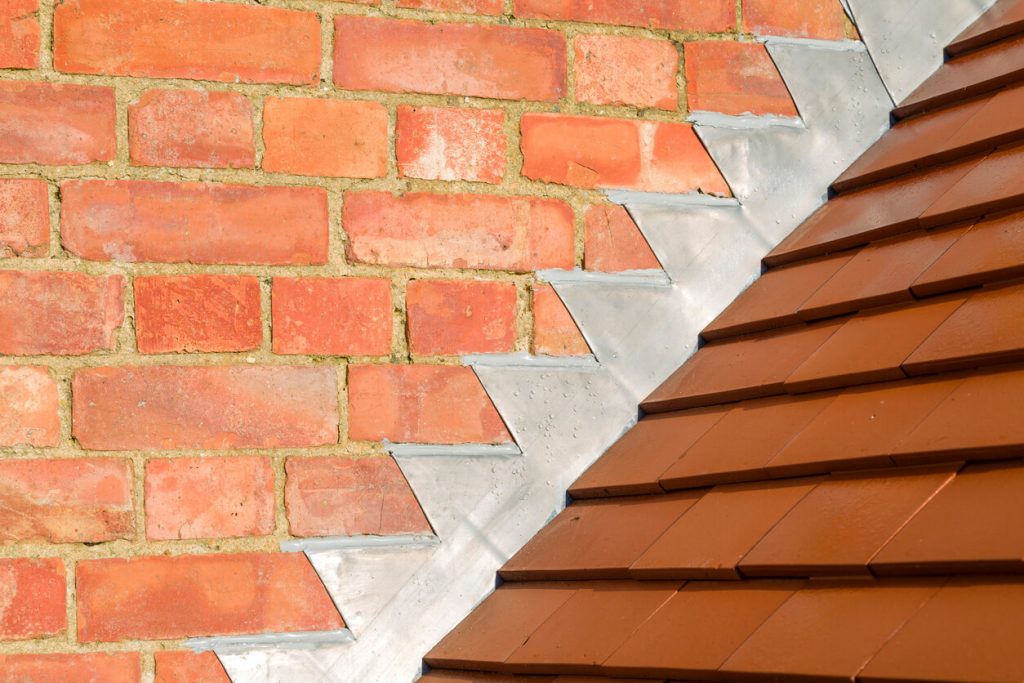
The metal strips that cover seams and joints between protrusions on your roof are called flashing. This includes the chimney, skylights, vents, and any other permanent fixtures that stick out of the roof.
If it’s in good condition, you can leave your existing flashing in place. If you see signs of corrosion, curling, lifting, or other damage, you’ll want to replace the flashing before adding new roofing materials.
4. How to Plan Your Shingle Layout

One of the most important parts of learning how to install roof shingles is figuring out how to lay the shingles out. Plan your layout before you start nailing shingles in place.
Each shingle manufacturer will have a suggested layout and mounting technique that you can use to guide the process.
If you lay them out correctly, you’ll create a water- and impact-resistant barrier between your house and the elements. However, if you leave gaps or plan incorrectly, you’ll leave openings for water and moisture to get into your attic space.
5. Installing Your Roof Shingles
Installing roofing materials the right way makes all the difference in your roof’s durability and functionality. The methods you’ll use will also depend on the types of materials you choose to install.
Installing Asphalt Shingles
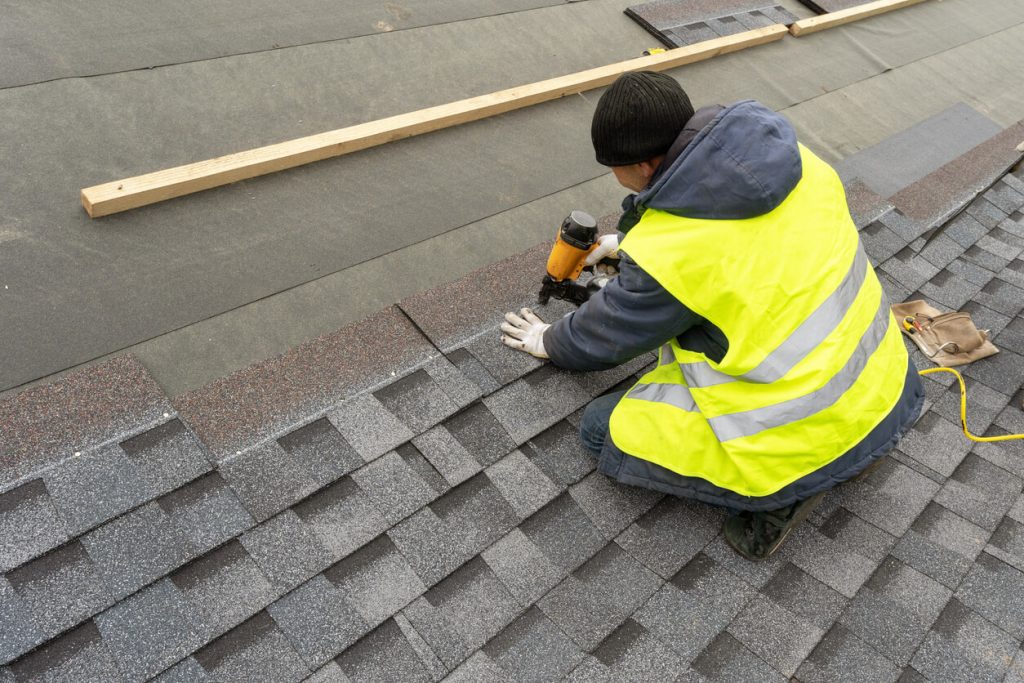
Before you nail the first shingle into place, check with the manufacturer and find out how they suggest you secure the shingles. They’ll have a recommended nailing pattern as well as recommended roofing nails for their products.
Now that you’ve taken the preparatory steps it’s time to actually learn how to install your shingles. Here is our recommended process.
- Working your way up and across the roof, begin laying out your shingle courses.
- Be aware of using proper nailing technique so that your nails always hold the top edge of the course beneath it.
- Example: Hammer one nail around 2 inches from each end of a shingle. Then secure another nail an inch above each cutout. So, your next course of shingles should cover the nails by 1 inch vertically.
- Follow this pattern of lining shingles up against the next and then nailing the shingles into place. You’ll want to follow this as a guide to keep your shingles straight.
- Cut your last shingle on each row to size and repeat this process all the way to the ridge.
- Once you’ve reached the ridge, bend the shingle over the ridge so that each side is equal and nail it into place with a single nail on each side.
- Do the same with the following shingle, continuing this step until you get to the far edge of the ridge.
- Cut the last ridge shingle to the preferred length that is needed, but be sure that none of your roof is exposed.
Tip: Be mindful to hammer nails straight rather than at an angle. Each individual shingle should be held down by 4-6 nails. Six nails are preferred for regions that have heavy wind.
Installing Clay Tiles
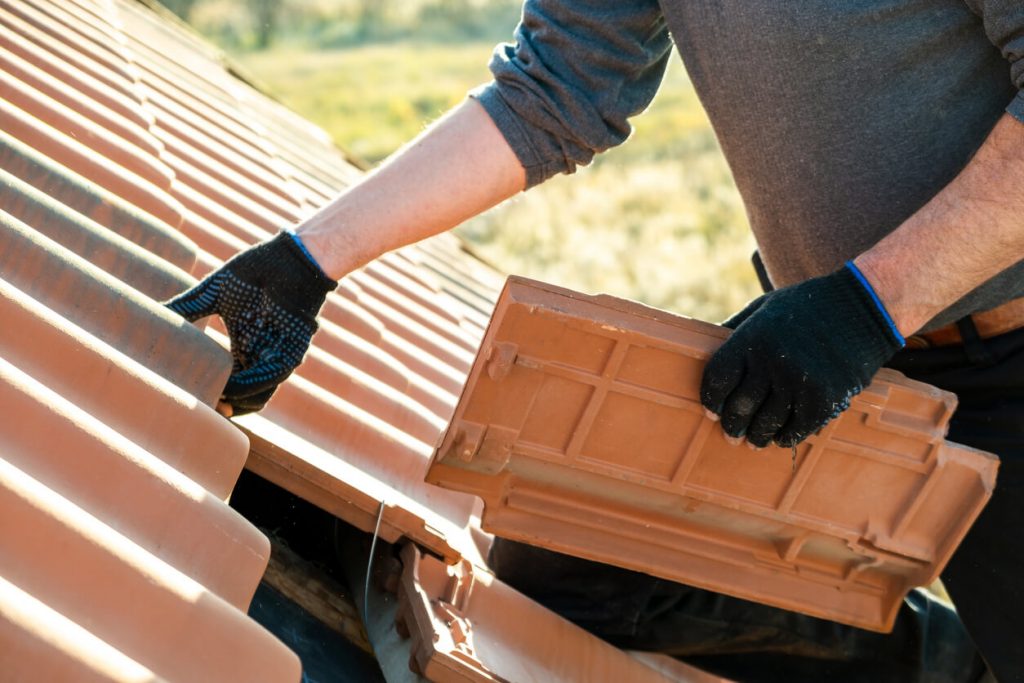
Clay tiles, like asphalt shingles, need to be installed in the right pattern. Map it out before you start placing tiles on the roof.
Once you have the pattern in place, nail the edge of the tile to the roof underlay. Then, spread a small amount of mortar beneath the tile to add more structural support. Repeat the process until the tiles are in place.
How to Install Metal Panels
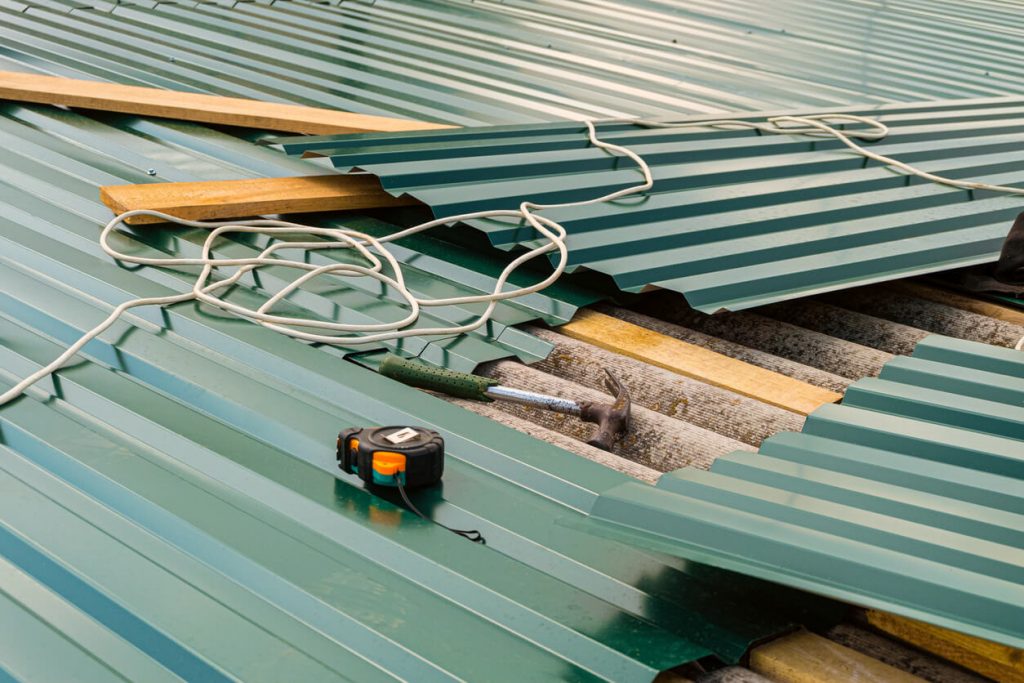
Metal panels are a bit trickier than asphalt shingles to install on your own. You’ll need help maneuvering the metal into place and making sure the seams between panels are secure.
Cut the metal to the right length before pulling it up on the roof. Then, add a layer of sealant tape along the seam where the next panel will slide into place. Repeat the process for each panel you add.
Then, secure the panels with metal roof fasteners. Take care not to overtighten the fasteners as this will damage the metal and increase your risk of leaks and damage.
How to Install Wood Shakes and Shingles

Before you can install wood shingles on your roof, you need to create the vent structure or sheathing. This keeps them from warping in the dampness and heat.
Once the structure is in place, plan the layout of the shingles and nail them into the sheathing. Take care to measure the shingles’ placement throughout the job to make sure you’re on the right track.
Review of Steps
- Make sure the area is safe
- Clean up the work area
- Check the weather forecast
- Wear the right clothes
- Use ladders correctly
- Prepare the roof
- Remove large debris
- Remove old roofing materials
- Install flashing
- Plan Your Shingle Layout
- Install Roof Shingles
Roof Replacements Are Expensive
Though it’s possible to learn how to install roof shingles on your own, it’s always best to leave it to an experienced professional. Roofing contractors know how to install different materials the right way, the very first time.
If you can, hire an experienced contractor and let them handle your roof replacement needs.
That said, did you know that there may be ways to extend the life of your current roof? Roof Maxx’s all-natural treatment rejuvenates your worn-out asphalt shingles, adding up to five years of life to otherwise outdated materials—at a fraction of the cost of a roof replacement.
Contact us to learn more or to find a local contractor who can help you protect your roof with ease.
